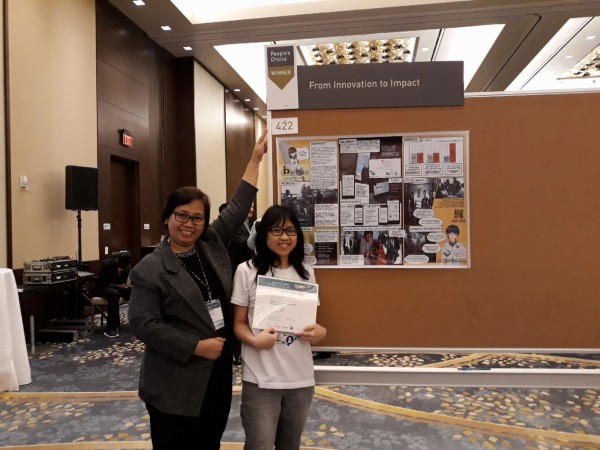Balangay, an MAVC-supported innovation project, was recently awarded the People’s Award at a poster competition held during the Global Innovation Week 2017, hosted by USAID.

Frei Sangil from the Balangay project receives People's Award at Innovation Week 2017
Frei Sangil, one half of the team behind the open cloud information system designed to help communities vulnerable to disasters in the Philippines, was both surprised and delighted to receive the award.
“Posters were set up and displayed over three days, and attendees could vote for their favourite by secret ballot. I did not think we would win as I had little chance to promote our poster, because I was speaking on a panel and had a packed schedule. Also, it felt a bit rough and ready (printed on tarpauline) compared to some of the slick, smooth and clearly-printed posters around us, so I purposefully skipped the awards ceremony, not expecting to win.
I had an early flight the next day, so I was actually sleeping when a fellow Philippino innovator burst into my room to announce that we had won award. I rushed straight to the venue, which I was I’m just wearing a casual t-shirt when receiving the award!
Of course, I am delighted to have had both the opportunity to share our work and for this receive international recognition.”
Previously, Balangay won a GOLD award at the 2015 Global Innovation Competition by Making All Voices count held at Jakarta, Indonesia, while Legazpi city won a CHAMPION at the 2016 eGOV awards by National ICT Confederation of the Philippines for Customer Empowerment with Balangay as its entry.
The city was also shortlisted in the 2017 Best Climate Practices, which is supported by the International Center for Climate Governance (ICCG), with Balangay again as its entry.
About Balangay
The Philippines is the fourth most disaster-prone country in the world , with more than 22 tropical storms hitting land each year. For affected communities, advance information on how to prepare for disasters is key to ensuring that families, homes and livelihoods are protected, and strong communication systems are required to make sure people can reach out for help both before, during and after a disaster strikes.
For Frei, who grew up in disaster-prone area, Balangay is about more than a business opportunity.
“I have seen horrible things happen, and these things could have been prevented with proper preparation.”
Launched in July 2015, this open, cloud-based information system was designed to improve the implementation and accountability of disaster preparedness, response and relief actions in the Philippines.
It’s a public resource on disaster information. It teaches citizens in the simplest possible way about disaster related information, preparing families for earthquakes, floods and typhoons. It also provides a real-time platform for reliable communication between local government units, NGOs and affected communities during emergencies. The system is now being used by 70 communities and members of the academe and private sector.